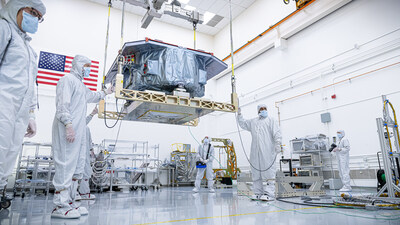BROOMFIELD, Colo., Aug. 13, 2024 /PRNewswire/ — BAE Systems (LON:BA) has successfully shipped the Nancy Grace Roman Space Telescope’s Wide Field Instrument (WFI) to NASA’s Goddard Space Flight Center in Greenbelt, Maryland, signaling the completion of integration and testing of the state-of-the-art instrument.
The WFI is the primary scientific instrument for the Roman Space Telescope, NASA’s next flagship astrophysics mission. The instrument is an advanced visible-to-near-infrared imager with additional spectral capabilities that will capture highly detailed images over wide swaths of the sky, offering a field of view at least 100 times greater than its predecessor, the Hubble Space Telescope, with a similar resolution. This instrument will dramatically improve the speed and scale of astronomical surveys, unlocking new insights into the mysteries of dark matter and dark energy, discovering distant galaxies and exoplanets, and studying how the structure of the universe has formed over billions of years.
BAE Systems designed and built the instrument’s opto-mechanical assembly, which includes the optical bench, element wheel, thermal control system, alignment compensation mechanism, and associated subsystem control electronics. NASA Goddard build the instrument’s focal plane system, relative calibration system, diffraction elements for the element wheel, and the instrument command and data handling electronics. BAE Systems also led the integration of the WFI’s components, along with environmental testing to ensure it can withstand the stresses of a launch and the conditions it will face in space.
“The Wide Field Instrument is one of the most sophisticated instruments ever constructed, and once it’s on orbit it will provide the scientific community with the most comprehensive surveys of the sky we’ve ever captured,” said Bonnie Patterson, senior director of civil space programs for BAE Systems Space & Mission Systems. “Our team is proud to support such an ambitious mission, and we look forward to seeing what amazing discoveries this instrument will help to make throughout the universe.”
With the instrument delivered, the Goddard team will lead the effort to integrate the WFI into the instrument carrier and mate it to the spacecraft bus later this year. The Roman Space Telescope is scheduled to launch by May 2027.
The work on the Roman Space Telescope continues the BAE Systems Space & Mission Systems’ legacy of contributing to all of NASA’s flagship astrophysics missions, including the James Webb Space Telescope and the Great Observatories: the Hubble Space Telescope, Spitzer Space Telescope, Chandra X-ray Observatory, and the Compton Gamma-Ray Observatory. BAE Systems was also recently selected to conduct a research effort for NASA’s planned Habitable Worlds Observatory, called the Ultra-stable Large Telescope Research and Analysis Program – Critical Technologies (ULTRA-CT).
For more information, please contact:
Sawyer D’Argonne, BAE Systems
Mobile: 303-250-6031
sawyer.dargonne@baesystems.us
www.baesystems.com/US
@BAESystemsInc
![]() View original content to download multimedia:https://www.prnewswire.com/news-releases/bae-systems-completes-testing-ships-primary-instrument-for-roman-space-telescope-302221511.html
View original content to download multimedia:https://www.prnewswire.com/news-releases/bae-systems-completes-testing-ships-primary-instrument-for-roman-space-telescope-302221511.html
SOURCE BAE Systems, Inc.



